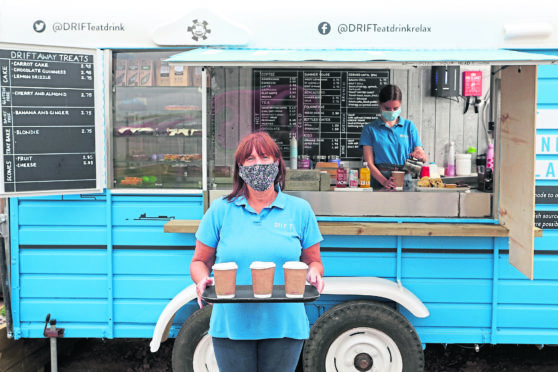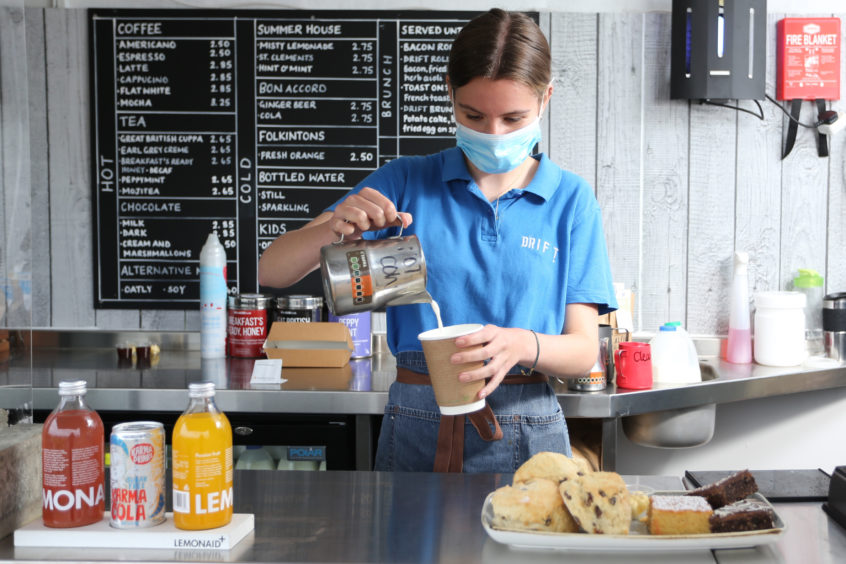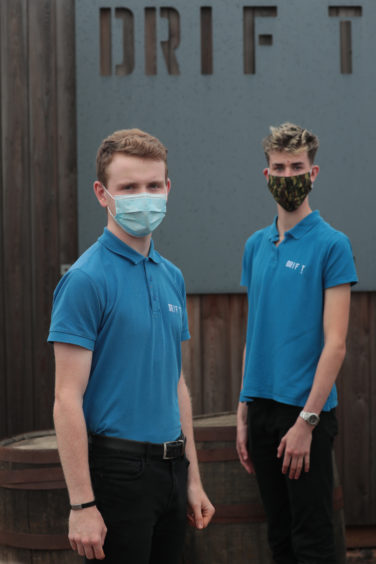
Throughout the decades, covering our faces has come to be associated with danger and defiance, from bank robbers in bandanas to superheroes concealing their everyday identities.
But the pandemic has changed all that, turning attitudes upside down and changing our perception of masks. Since face coverings became compulsory in shops and enclosed spaces on July 10, most Scots have quickly changed their thinking, seeing masks as a responsible and unifying response to an uncertain threat.
Many of us adjusting to this new normal are struggling to become accustomed to communicating when our faces are obscured and expressions are hidden.
With our mouths covered, verbal communication will become slightly more difficult, especially for those working in customer-facing roles. However, Jo McNicol, owner of Drift Café in North Berwick, says new safety measures, including the use of facial visors, have helped rather than hindered her staff’s ability to provide good service.
She explained: “We’re trying to make use of face shields as opposed to face masks, especially with our hosts. The staff are more than comfortable wearing a mask, and actually most prefer it because it gives them the knowledge they are protecting themselves and the customers, too. And we’ve found most customers are wearing masks as well.
“It’s a very different way of working but I’m pleased to say everyone – staff and customers – are doing what they need to do to ensure it’s safe. It’s strange, but we’re calling it our ‘new relaxed normal’ – that’s our catchphrase to ensure our customers feel as relaxed as they can be, and therefore our staff can be, too. It’s all about adapting to change, and that’s just what we’ve got to do for the foreseeable future.”
One profession known for its love of a good natter is hairdressing, and Stuart Whitelaw, founder of Mesart Hair in Glasgow, says wearing a mask hasn’t stopped his stylists or clients from enjoying a trip to the salon.
He said: “Until now, I don’t think I’d ever realised how much you watch someone’s lips when you’re talking, but everyone has managed to settle into a new normal.
“Some clients did say they were a bit nervous or worried about coming back into the salon, but most have said it’s not as scary as they thought it would be. It’s been great.”
People tend to conform well if there is a really good public health reason
Nick Davies, a leading psychotherapist and body language expert, said: “Studies on emotional communication show that words represent 7%, voice – including tone, intonation and volume – account for 38% and 55% is body language. So, a mask is likely to muffle the auditory part and we won’t see the movement of the cheeks, lips and chin, which are all important for interpreting the ‘meaning’ of our words.
“It’s likely to lead to people projecting their voices more, and more miscommunication, possibly leading to disagreements, and people communicating only essential information.
“And, yes, we will gesticulate more, much as we do on holiday when trying to communicate with someone who knows little English.”
While communication becomes trickier, the perception of protection and communal effort will be felt more strongly, according to Dr Christopher Hand, a senior lecturer in psychology at Glasgow Caledonian University.
“In certain countries, wearing masks for public hygiene reasons has been the norm for a long time, particularly on transport, but it’s something that’s quite alien to us,” he explained. “The masks are really important in terms of limiting transmission, but there’s also the psychological aspect of giving people a feeling of safety.
“If you’re around people that have got visors or masks on, you might feel a bit more protected from them and, similarly, you may feel a wee bit more confident going back into the world.”
Although a recent report from The Royal Society described the UK as “way behind many countries in terms of wearing masks” and research conducted in late April suggested only 25% of people had picked up the habit, Dr Hand believes if there is clear messaging from the Government, most people will make masks part of their routine, where possible.
He said: “People tend to conform quite well, especially when there’s a really good public health reason, and a clear consistent message behind why the masks are there. It’s not a political thing, it’s not a self-indulgent thing, it’s for everyone’s benefit. By and large, people will be really tolerant of the reasons why someone can’t wear a mask, but I do think because of the way our brains work, and due to the pressure we’re all under right now, it might be tempting to automatically assume someone without a face covering is in the wrong.
“It does require extra mental effort to remember that there are very valid reasons why people will not be wearing masks. We need lots of public communication to remind people.”
As the weeks and months march by, and we continue to recite “wallet, keys, phone and mask” as a reminder before we leave the house, Dr Hand says we may also have to adapt our behaviour to compensate for half of our face remaining covered.
He said: “The lower part of the face in particular is so crucial for expressing things like happiness, sadness, surprise and disgust, as well as the actual physics and the acoustics of speech, so, yes, it’s going to take a bit of getting used to.
“Plus, the mask has quite a profound effect on things like speech perception, particularly for vulnerable groups, such as the elderly, those who are hard of hearing and young children, who maybe rely a lot on looking at mouth shape when people are making words.
“So, we might actually have to get into an artificial habit of telling people how we feel, saying things like, ‘I’m really happy to hear that’ and using emotional words when we’re speaking. However, people are quite adept at picking up on body language, and can tell whether someone is perhaps open or anxious, and there will be a lot of hand movements now.
“So, people should still be able to pick up on a lot of these subtle cues.”
Dr Asher Siddiqi, medical expert at Transform, said: “Masks shouldn’t pose too much of a problem with communication. But, for people who are hard of hearing or have partial hearing loss, masks do remove some of the non-verbal cues, and they can make conversation less clear in some circumstances.
“However, we know the reasons why we have to wear them, and those outweigh the negatives of face mask-wearing. As medical professionals, we’ve been leading by example and taking extra precautions to protect ourselves and the community. It’s a two-way process.”

Enjoy the convenience of having The Sunday Post delivered as a digital ePaper straight to your smartphone, tablet or computer.
Subscribe for only £5.49 a month and enjoy all the benefits of the printed paper as a digital replica.
Subscribe © Stewart Attwood
© Stewart Attwood © Stewart Atwood
© Stewart Atwood